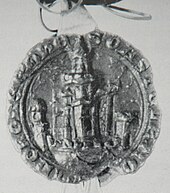Grönenberg Castle
| Grönenberg Castle | ||
|---|---|---|
| Alternative name (s): | Grönenburg | |
| Creation time : | 1246 to 1251 | |
| Castle type : | Niederungsburg, moth | |
| Conservation status: | Burgstall, castle hill | |
| Place: | Melle | |
| Geographical location | 52 ° 12 '18.6 " N , 8 ° 19' 40.3" E | |
|
|
||
The castle Grönenberg even Groenefeld Burg called, is a Outbound Turmhügelburg (Motte) in Grönenberg Park in the city of Melle in the district of Osnabrück in Lower Saxony .
The motte was from 1241 to 1251 as a pin castle founded and was canceled in 1574 up to the castle tower, which then served as a prison until the 1,771th In 1838 the rest is said to have been leveled.
The castle complex in a former marshland was a two-part moth system surrounded by a double wall and ditch system , whose moats with upstream small earth walls were fed by the water of the Else . The core castle was located on the 5 meter high castle hill with a diameter of 33 meters that is still preserved today.
Geographical location
The castle is located in today's city center of Melle (Friedrich-Ludwig-Jahn-Straße 2), about 25 km east of Osnabrück and 25 km northwest of Bielefeld . About 100 meters away, the Else River flows north of the former castle in a valley between the Wiehen Mountains and the Teutoburg Forest ( Osning ).
history

Bishop Engelbert von Osnabrück had the state castle of Gröneberg built to protect and secure the Osnabrück bishopric . 65 armed knights ensured the security of the castle and the nearby monastery border. Every year on St. Martin's Day, November 11th, the bishop gathered his castle men at the castle and drank the Burgmann wine with them, which was paid for from the monastery treasury. The castle became the center of administration when the administrative order of 1553 brought about a new regulation of responsibilities.
Its military importance had waned as a result of political changes, especially after the Thirty Years' War . The buildings fell into disrepair over time and the Grafenturm was blown up in 1771. The fortifications of the town of Melle, located near the castle, were already heavily developed in the mid-12th century. It consisted of one meter thick walls, protruding towers and a moat. The fortified ramparts made it possible to successfully repel the siege of Simon von der Lippe in 1299. As a thank you for its loyal followers, Melle was given a constitution as early as 1316. Further raids, arson and looting followed in 1449 and 1451.
Todays use
The castle hill is located in the middle of today's Grönenberg Park, a local recreation area in which the Lower Saxony state gymnastics school and the Grönegau museum are located. On the former castle grounds, there is a war memorial enclosed by a ring-shaped wall , which can be reached via a spacious sandstone staircase.
literature
- Heimatverein Melle (Hrsg.): Grönenberger Heimathefte. Knight seats and noble courts in Grönegau . Issue 11, Melle 1967.
- District of Melle (ed.): The Grönegau in the past and present. Home register of the district of Melle . Fromm, Osnabrück 1968.
- Edgar Schroeder (Ed.): Melle in eight centuries . Ernst Knoth, Melle 1969.
See also
- City history of Melle
- St. Matthew (Melle)
- Entry on Grönenberg Castle in the private database "Alle Burgen". Retrieved March 20, 2020.
- List of German hilltop castles
Web links
Individual evidence
- ↑ Entry on Grönenberg Castle in the private database "Alle Burgen". Retrieved March 20, 2020.
- ↑ Edgar Schroeder (Ed.): Melle in eight centuries . Ernst Knoth, Melle 1969.

